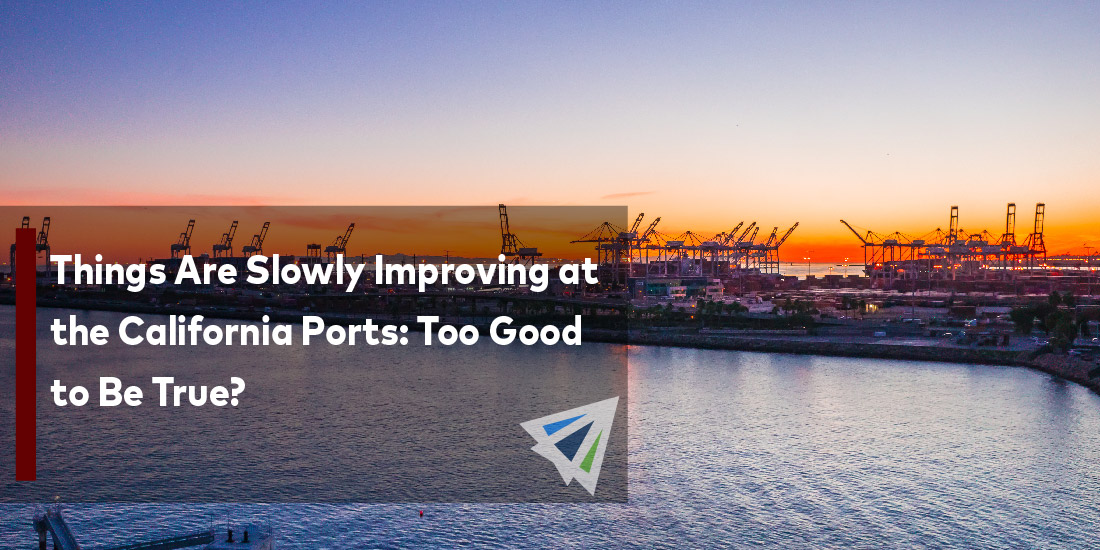Things Are Slowly Improving at the California Ports: Too Good to Be True?
We’ve been witnessing some of the worst congestion ever seen at the southern Californian ports of Los Angeles and Long Beach for quite some time. Previous queues of 60 ships seemed extreme last year, but they were topped in recent months by a stack up of over 100 ships waiting at anchor off the coasts of the ports. But recent news has it that things may be on the upswing as congestion relieves and cargo movement off of ships and through ports is becoming more efficient. Of course, this begs the question—is this too good to be true?
Word from officials is that this congestion relief may be short lived.
It’s looking like inbound cargo volumes are going to increase rapidly due to retailers’ need to replenish inventories. Additionally, the already high volume of Asian vessels on their way to the U.S. are expected to arrive in the next few weeks. This week’s lockdowns in Shenzhen could also lead to a massive influx of cargo after factories reopen. Similar to what we saw in the back half of 2020 as businesses sought to cover their losses and replenish inventory after major lockdowns.
In addition to all this, annual peak-season, June, lies in the not-too-distant future. If congestion hits hard over the next month or two, it could prove difficult to clear port grounds and restore efficiency before peak-season import volume strikes southern California again.
Cargo Levels at Los Angeles and Long Beach
While November and December were bad months (even in comparison to pre-pandemic cargo levels), much of this has been fixed as inland bottlenecks and port operational efficiency have increased. The Port of Los Angeles had its best February yet with a total throughput of 857,764 TEUs, which was up 7.3 percent year on year. Long Beach moved 796,560 TEUs, which was up 3.2 percent year on year.
In addition to the improved throughput of containers, congestion off the coast of southern California has improved drastically. While the number of ships waiting offshore sat at 101 in November and December of 2021, that number had fallen all the way to 43 on January 1 and is continuing to improve. Additionally, on-dock rail time has been reduced from an average of 13.5 days to 4 days. A major improvement that’s restoring efficiency to one of the greatest inland supply chain bottlenecks.
Why Will Congestion Relief Be Short Lived?
This all sounds like incredible news. Efficiency is being restored, congestion is dropping, and fewer ships are waiting offshore. But why is this the case?
Certainly, some of the reduced congestion is due to actual improvements happening with inland transportation and port operations. But much of it is actually due to a reduction in Asian vessels dispatching to the U.S. Fewer ships leave Asia around the Lunar New Year which is something that is expected to change drastically in the coming weeks.
Currently, experts know with near certainty that cargo volumes and congestion are going to increase at the Long Beach and Los Angeles ports, but the details are a bit fuzzy on the degree to which the congestion will hit. This is largely due to variables that are still up in the air.
Congestion will depend on how hard the Chinese lockdowns hit factories and ports. Major lockdowns can create backlogs of orders that contribute to congestion. But once again, the best experts can do at this point in time is monitor the situation and wait. In the meantime, carriers are continuing to work towards improvements in their supply chain efficiency, and ports are working as fast as possible to berth and unload ships. Congestion is expected to rise, but the degree to which that happens is still unknown.
If you would like more information regarding this topic, contact our team at InterlogUSA and we will be happy to assist you on any questions or comments you may have. In addition, we have our weekly market updates that can provide you with relevant freight news, updates, developments across the industry, and more.
